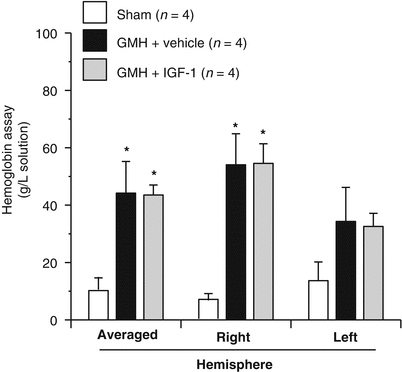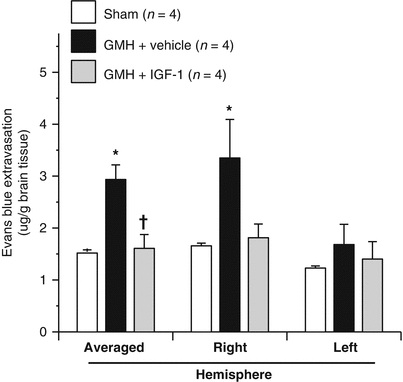Fig. 1
Developmental milestone, measured by negative geotropism (seconds), 72 h after collagenase infusion; (asterisk) <0.05 compared with sham; (cross) <0.05 compared with GMH (vehicle); SEM standard error of the mean; n = 6/group

Fig. 2
Hemoglobin assay, measured by spectrophotometer, 72 h after collagenase infusion; (asterisk) <0.05 compared with sham; SEM standard error of the mean; n = 4/group

Fig. 3
Evans blue, measured by spectrophotometer, 72 h after collagenase infusion; (asterisk) <0.05 compared with sham; (cross) <0.05 compared with GMH (vehicle); SEM standard error of the mean; n = 4/group
Conclusion
Translational stroke studies, in particular those involving animal modeling, are greatly needed to safely integrate basic preclinical scientific principles ahead of further clinical applications [19–23]. This study showed that intranasal IGF-1 treated animals had improved neurological function and amelioration of BBB permeability, edema, and re-bleeding. Therefore, IGF-1 may eventually be shown to play a part in protective brain signaling following GMH. Our observed protective effect may thus offer new promise for potential novel investigations of treatment targeting this vulnerable patient population.
Acknowledgment
This study was partially supported by the National Institutes of Health grant RO1 NS078755 (Dr. Zhang).
Disclosures
None
References
1.
Ballabh P (2010) Intraventricular hemorrhage in premature infants: mechanism of disease. Pediatr Res 67:1–8PubMedCentralCrossRefPubMed
2.
Zhao J, Chen Z, Xi G, Keep RF, Hua Y (2014) Deferoxamine attenuates acute hydrocephalus after traumatic brain injury in rats. Transl Stroke Res 5:586–594PubMedCentralCrossRefPubMed
3.
4.
Chen Q, Zhang J, Guo J, Tang J, Tao Y, Li L, Feng H, Chen Z (2014) Chronic hydrocephalus and perihematomal tissue injury developed in a rat model of intracerebral hemorrhage with ventricular extension. Transl Stroke Res. doi:10.1007/s12975-014-0367-5
5.









